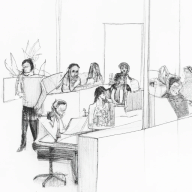
The Office is Great, The Office is Horrible
The majority of my working life has been spent in an office. I’ve worked in many varied office environments. Offices with actual walls and doors, depressing cubical farms, decent cubical farms1, small communal offices2, and open floor plans. Offices sparsely appointed, and offices with every manner of workplace perk.
The few years before the pandemic my work schedule was punctuated by working from home one or two days a week. Those at home days was where work got done that required concentration. Frequently that work compressed into just the morning due to the wealth of quiet focus time the home office afforded. The time in office was where lots of great discussions happened (rarely about work), friendships and bonds with coworkers were formed, and far too many meetings happened. The office also served as the after hours space for happy hours and game nights (which I remember fondly).
I’ve been working from my home office for over 3 years now. I have no desire to work full time in a depressingly common modern open office. The return to office attempts by companies of all sizes have been well documented in the news this year. The focus tends to be on collaboration and culture. I strongly support the desire to have in-person time with coworkers, it helps build familiarity and trust. Thankfully you do not need an office to achieve that. The work retreat is not a novel concept. It also does not need to be restricted to company leadership. Paying everybody to travel to the same location for a week works just fine (and you can choose a far better location than an office). I’d wager in-person company retreats for fully remote companies are more cost effective than companies going hybrid maintaining a full time office space.
As return to office and hybrid work schedules are communicated I rarely see any mention of what companies are doing to improve the office environment for their staff. It feels like a missed opportunity to reimagine what the office could be, especially if you know less than half of your staff will present at any one time. All the photos accompanying the news articles are the familiar sight of people in rows of desks, staring at monitors and wearing headphones. I see all the same reasons in these photos that caused me to want to abandon the office in the first place to get work done.
As return to office efforts intensify what I observe is company leadership wanting things to go back to how they were pre-pandemic. Open offices with cramped desk space and harsh overhead lighting. People sitting shoulder to shoulder, almost always wearing headphones, trying to wish away their lack of personal space and privacy. Never enough open meeting rooms. Long commutes stealing precious time with family and friends. I get it, performance management is hard and face time is an easy crutch to fall back on, but lazy management is not a reason to catapult people back into the worst parts of the office environment.
If a company wants me to work in-person at an office all they have to do is provide an office environment that makes me think:
“I want to go to the office, I really need to get some work done.”
It’s as simple as that. Provide me an office that is so ridiculously superior to my home office that it would be impossible to ignore the allure of going into the office to work. I do not need an adult play pen. I do not need free snacks, napping pods, foosball tables, and beer carts. I just need a place that allows me to focus and get work done. Give me a quiet space with natural light, a decent sized desk, and equipment of my choice. Provide meeting rooms that are well ventilated, welcoming, and facilitate conversation and collaboration. I don’t even need free coffee.3 This should not a complicated problem to solve.
I do miss having an office to go to at times. I miss the camaraderie with coworkers. I miss being able to easily read the room during meetings. I miss forming meaningful relationships with people. I miss my daily bike commute. I remain optimistic that companies will take away some important lessons from the forced experiment of remote work brought about by the pandemic. I’m hopeful that the modern office can be reinvented. But until then I’ll stay in my home office. It has a door, natural light, it’s quiet, has my equipment of choice, and there’s good coffee.
References
- https://www.nytimes.com/2023/04/24/business/remote-work-feedback.html
- https://nataliaemanuel.github.io/ne_website/EHP_Power_of_Proximity.pdf
- https://freakonomics.com/podcast/the-unintended-consequences-of-working-from-home/
- https://hbr.org/2023/01/research-where-managers-and-employees-disagree-about-remote-work
- https://www.nytimes.com/2023/04/11/magazine/return-to-office-consultants.html
- https://www.nytimes.com/2023/03/02/business/hybrid-work-from-home-office.html
Footnotes
-
When I worked at MapQuest our office park building had plate glass windows around the entire perimeter with gently tinted UV filtering glass. We also had full height cubicles walls surrounding a reasonably sized L-shaped desk. Our management was surprisingly supportive of us removing interior cubicle walls and forming small bullpens with our immediate team. This allowed for the collaboration and focus time we desired, and as an added bonus got people more space and better access to the copious natural light and views of nature along the edges of the floor plan. It is my one datapoint that full height cubicles walls can actually serve a useful purpose. ↩
-
I loved the small 1200 sqft office we had at a previous startup. Sharing a private workspace with five other people was glorious. It’s a small enough group that you can establish an agreed upon schedule of focus time and meeting time. You never had to fight for whiteboard space, and creative use of large bookshelves created a natural flow between private desk space and communal space. ↩
-
It’s neither difficult nor expensive furnish my own electric kettle, grinder, beans, and AeroPress. ↩